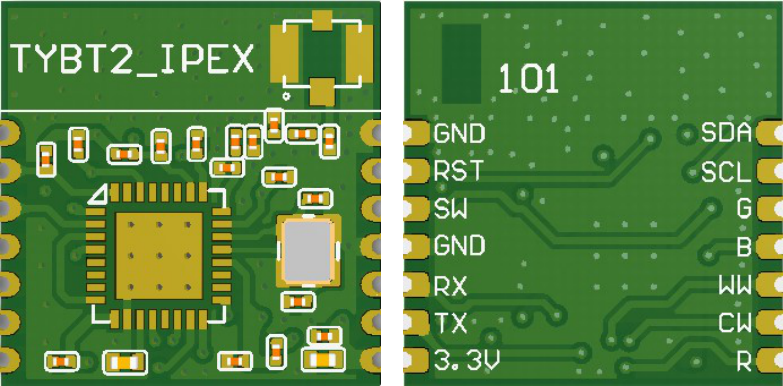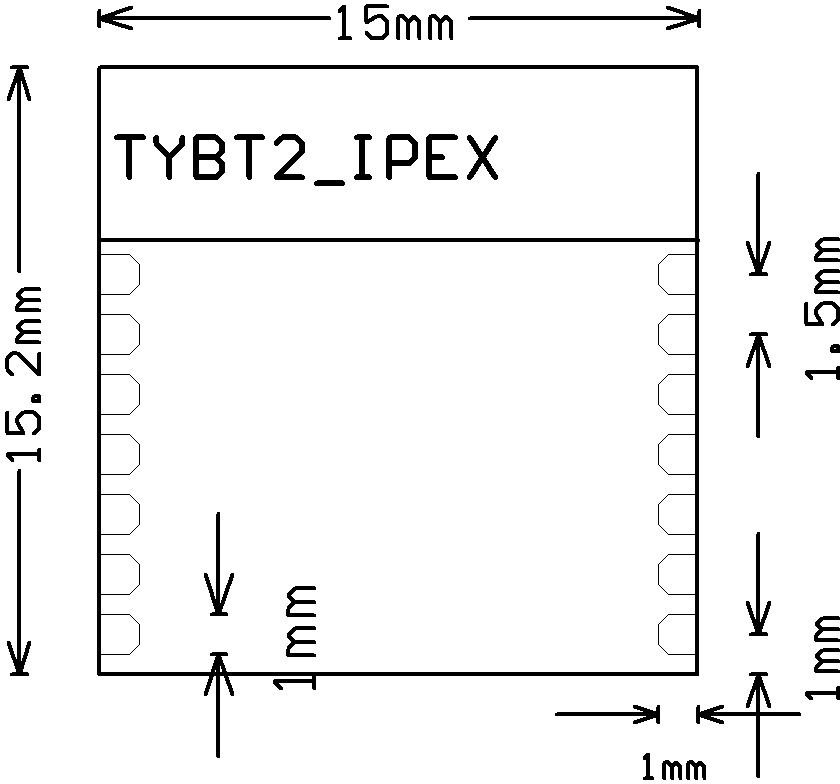TYBT2-IPEX Module Datasheet
Last Updated on : 2025-03-05 01:32:11download
Product overview
TYBT2-IPEX is a Bluetooth Low Energy (LE) module designed by Hangzhou Tuya Technology Corporation. The Bluetooth LE Module consists of a highly integrated wireless Bluetooth chip TLSR8266 and some extra electric circuits that have been programmed with Bluetooth network protocol and plenty of software examples. TYBT2-IPEX includes a 32-bit CPU, Bluetooth LE/2.4G radio, 512K byte flash, 16k SRAM, and 9 multiplex IO pins.
Features
- Integrated low power consumption 32-bit CPU, also known as application processor
- Basic frequency of the CPU can support 48 MHz
- Supply voltage range: 1.9V to 3.6V
- Peripherals: 5 × PWM, 1 × I2C, 1 × UART
- Bluetooth RF features:
- Compatible with Bluetooth 4.0
- Transmitting data rate can go up to 2Mbps
- TX transmitting power: +7dBm
- RX receiving sensitivity: -92dBm
- AES hardware encryption
- External 2.4G Antenna
- Operating temperature range: -20°C to 105°C
Main application fields
-
Intelligent LED
-
Intelligent household applications
-
Intelligent low-power consumption sensors
Dimensions and footprint
Dimensions
TTYBT2-IPEX has double sides of pins. The distance between each Pin is 1.5mm.
Size of TYBT2-IPEX: 15mm(W) × 15.2mm(L).
Figure 2 shows the dimensions of TYBT2-IPEX.
 )
)
Pin definition
Table 1 shows the general pin attributes of TYBT2-IPEX
Table 1. The typical pin definition of TYBT2-IPEX
| Pin No. | Name | Type | Description |
|---|---|---|---|
| 1 | SDA | I/O | I2C, data interface, internal pull-up 4.7k resistance |
| 2 | SCL | I/O | I2C, clock interface, internal pull-up 4.7k resistance |
| 3 | G | I/O | Normal IO pin, which can be used as PWM output pin, default for Green LED line |
| 4 | B | I/O | Normal IO pin, which can be used as PWM output pin, default for Blue LED line |
| 5 | WW | I/O | Normal IO pin, which can be used as PWM output pin, default for Warm White LED line |
| 6 | CW | I/O | Normal IO pin, which can be used as PWM output pin, default for Cold White LED line |
| 7 | R | I/O | Normal IO pin, which can be used as PWM output pin, default for Red LED line |
| 8 | 3.3V | P | Supply voltage |
| 9 | TX | I/O | UART TX, which can be used as a normal IO pin |
| 10 | RX | I/O | UART RX, which can be used as a normal IO pin |
| 11 | GND | P | Ground |
| 12 | SW | I/O | Bluetooth chipset burning pin |
| 13 | RST | I | Reset pin for the module, internal pull-up 4.7k resistance |
| 14 | GND | P | Ground |
P: Power supply pins. I/O: Digital input or output pins.- SW pin is ONLY used for burning firmware, Can NOT be used for other functions.
- While Pin4 and Pin12 are used for I2C functions, external 4.7k pull-up resistances are necessary.
- When the WW pin is outputting the PWM signal, It has an opposite phase comparing the PWM signal from the R/G/B/CW pins. If there’s any customization needed for PWM output, please contact our BD manager.
Electrical characteristics
Absolute maximum ratings
Table 2. Absolute maximum ratings
| Parameter | Description | Min. | Max. | Unit |
|---|---|---|---|---|
| Ts | Storage temperature | -20 | 85 | °C |
| VCC | Supply voltage | -0.3 | 3.9 | V |
| Electrostatic release quantity (Human body model) | TAMB-25°C | - | 2 | KV |
| Electrostatic release quantity (Machine model) | TAMB-25°C | - | 0.5 | KV |
Electrical conditions
Table 3.2 Electrical conditions
| Parameter | Description | Min. | Typical | Max. | Unit |
|---|---|---|---|---|---|
| Ta | Temperature for Commercial grade | -20 | - | 85 | °C |
| VCC | Supply voltage | 2.5 | 3.3 | 3.6 | V |
| VIL | IO negative level input | -0.3 | - | VCC*0.25 | V |
| VIH | IO positive level input | VCC*0.75 | - | VCC | V |
| VOL | IO negative level output | - | - | VCC*0.1 | V |
| VoH | IO positive level output | VCC*0.8 | - | VCC | V |
Transmitting current consumptions
Table 3.3 TX current consumption
| Parameter | Mode | Typical | Unit |
|---|---|---|---|
| Itx | Continuously transmitting, 0dBm power output | 13 | mA |
| Irx | Continuously receiving | 13 | mA |
| IDC | Normal working mode | 80 | μA |
Radio specification
Basic radio frequency characteristics
Table 4.1 Basic radio frequency characteristics
| Parameter | Description |
|---|---|
| Working Frequency | 2.4GHz ISM band |
| Radio standard | Bluetooth LE 4.0 |
| Data transmitting rate | 1Mbps, 2Mbps |
| Type of Antenna | External 2.4G Antenna |
Transmitting power
Table 4.2 Transmitting power
| Parameter | Min. | Typical | Max. | Unit |
|---|---|---|---|---|
| RF Average output power consumption | 3.8 | 7 | - | dBm |
| 20dB bandwidth | - | 1000 | - | KHz |
Receiving sensitivity
Table 4.3 Receiving sensitivity
| Parameter | Rate | Min. | Typical | Max. | Unit |
|---|---|---|---|---|---|
| RX sensitivity | 1Mbps | -93 | -92 | -90 | dBm |
| Frequency bias error | - | -300 | - | 300 | KHz |
| Co-channel interference Restrain | - | - | -7 | - | dB |
Antenna information
Antenna type
TYBT2-IPEX requires an external 2.4GHz band antenna with an IPEX generation terminal on one end.
Reduce antenna interference
In order to have the best RF performance, it’s recommended to keep a minimum 15mm distance between the antenna part and the other metal pieces. Also, in order to minimize the attenuation of RF performance and to facilitate the free emission of RF signals, the antenna is preferably placed close to the edge, meanwhile, the antenna cannot be surrounded by metal objects or blocked by some high devices.
To ensure good isolation, when there are two or more antennas of the same frequency band, the distance between the antennas should be widened as much as possible, it is preferably greater than 5 cm.
Packaging and production guide
Mechanical dimensions
Figure 4. Dimensions of the module

Production guide
The storage for the delivered module should meet the following condition:
- The anti-moisture bag should be kept in an environment with temperature < 30°C and humidity < 85% RH.
- The expiration date is 6 months since the dry packaging products are sealed.
Cautions:
- All the operators should wear an electrostatic ring in the whole process of production.
- While operating, water and dirt should not have any contact with the modules.
Appendix:Statement
FCC Caution: Any changes or modifications not expressly approved by the party responsible for compliance could void the user’s authority to operate this device.
This device complies with Part 15 of the FCC Rules. Operation is subject to the following two conditions: (1) This device may not cause harmful interference, and (2) this device must accept any interference received, including interference that may cause undesired operation.
Note: This device has been tested and found to comply with the limits for a Class B digital device, according to part 15 of the FCC Rules. These limits are designed to provide reasonable protection against harmful interference in a residential installation. This device generates, uses, and can radiate radio frequency energy and, if not installed and used following the instructions, may cause harmful interference to radio communications. However, there is no guarantee that interference will not occur in a particular installation.
If this device does cause harmful interference to radio or television reception, which can be determined by turning the device off and on, the user is encouraged to try to correct the interference by one or more of the following measures:
- Reorient or relocate the receiving antenna.
- Increase the separation between the device and receiver.
- Connect the device to an outlet on a circuit different from that to which the receiver is connected.
- Consult the dealer or an experienced radio/TV technician for help.
Radiation Exposure Statement
This device complies with FCC radiation exposure limits set forth for an uncontrolled rolled environment. This device should be installed and operated with a minimum distance of 20cm between the radiator and your body.
Important Note
This radio module must not be installed to co-locate and operate simultaneously with other radios in the host system except following FCC multi-transmitter product procedures. Additional testing and device authorization may be required to operate simultaneously with other radios.
The availability of some specific channels and/or operational frequency bands are country dependent and are firmware programmed at the factory to match the intended destination. The firmware setting is not accessible to the end-user.
The host product manufacturer is responsible for compliance with any other FCC rules that apply to the host not covered by the modular transmitter grant of certification. The final host product still requires Part 15 Subpart B compliance testing with the modular transmitter installed.
The end-user manual shall include all required regulatory information/warnings as shown in this manual, including “This product must be installed and operated with a minimum distance of 20 cm between the radiator and user body”.
The RF module is considered as a limited modular transmitter according to FCC rules. Even though the RF module gets an FCC ID, the host product manufacturer can not use the FCC ID on the final product directly. In these circumstances, the host product manufacturer integrator will be responsible for re-evaluating the end product (including the transmitter) and obtaining the FCC authorization by a Class II permissive change application or a new application.
Declaration of Conformity European Notice

Hereby, Hangzhou Tuya Information Technology Co., Ltd declares that this module product is in compliance with essential requirements and other relevant provisions of Directive 2014/53/EU,2011/65/EU. A copy of the Declaration of conformity can be found at https://www.tuya.com.

This product must not be disposed of as normal household waste, in accordance with the EU directive for waste electrical and electronic equipment (WEEE-2012/19/EU). Instead, it should be disposed of by returning it to the point of sale, or to a municipal recycling collection point.
The device could be used with a separation distance of 20cm from the human body.
Is this page helpful?
YesFeedbackIs this page helpful?
YesFeedback





